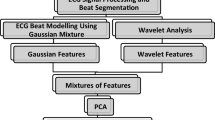Abstract
The role of electrocardiogram (ECG) as a noninvasive technique for detecting and diagnosing cardiac problems cannot be overemphasized. This paper introduces a modified version of boosted mixture of experts for the classification of three types of ECG beats. Our two-step preloading procedure, along noise injection, also regarded as smoothing regularization, proved to be a promising, effective, and safe means of classifying arrhythmias. The proposed model, according to the nature of implementation, is called coupled boosting by filtering and preloaded mixture of experts. The experimental results show our proposed method have better classification rate against other compared methods. Comparative evaluation is accomplished with ECG signals from MIT–BIH arrhythmia database.






Similar content being viewed by others
References
Fauci A, Braunwald E, Kasper DL, Hauser SL, Longo DL, Jameson JL, Loscalzo J (2008) Harrison’s principles of internal medicine, 17th edn. McGraw-Hill, New York, pp 1–2754
Tsipouras MG, Fotiadis DI (2004) Automatic arrhythmia detection based on time and time-frequency analysis of heart rate variability. Comput Methods Programs Biomed 74:95–108
Tsipouras MG, Fotiadis DI, Sideris D (2005) An arrhythmia classification system RR-interval signal. Artif Intell Med 33:237–250
Osowski S, Linh TH (2001) ECG beat recognition using fuzzy hybrid neural network. IEEE Trans Biomed Eng 48(11):1265–1271
Güler I, Ubeyli ED (2005) ECG beat classifier designed by combined neural network model. Pattern Recogn 38(2):199–208
Hu YH, Palreddy S, Tompkins W (1997) A patient adaptable ECG beat classifier using a mixture of experts approach. IEEE Trans Biomed Eng 44:891–900
Minami K, Nakajima H, Toyoshima T (1999) Real-time discrimination of ventricular tachyarrhythmia with fourier-transform neural network. IEEE Trans Biomed Eng 46:179–185
Ebrahimzadeh A, Khazaee A (2009) Detection of premature ventricular contractions using MLP neural networks: a comparative study. Measurement 43:103–112
Ebrahimpour R, Sajedin A, Moussavi SZ, Farizhendi AG (in press) A bio-inspired computational neural model for illustration face and car expertise effect on the gateway to the right FFA. Int J Innov Comput Inf Control 8(5B):3451–3466
Javadi M, Ebrahimpour R, Sajedin A, Faridi S, Zakernejad Sh (2011) Improving ECG classification accuracy using an ensemble of neural network modules. PLoS One 6:1–13
Güler I, Ubeyli ED (2005) A modified mixture of experts network structure for ECG beats classification with diverse features. Eng Appl Artif Intell 18:845–856
Übeyli ED (2009) Combining recurrent neural networks with eigenvector methods for classification of ECG beats. Digit Signal Process 19:320–329
Osowski S, Markiewicz T, Hoai LT (2008) Recognition and classification system of arrhythmia using ensemble of neural networks. Measurement 41:610–617
Özbay Y, Ceylan R, Karlik B (2006) A fuzzy clustering neural network architecture for classification of ECG arrhythmias. Comput Biol Med 36:376–388
Jacobs RA, Jordan MI, Nowlan SJ, Hinton GE (1991) Adaptive mixtures of local experts. Neural Comput 3(1):79–87
Chen K, Xu L, Chi H (1999) Improved learning algorithms for mixture of experts in multiclass classification. Neural Netw 12(9):1229–1252
Ebrahimpour R, Kabir E, Yousefi MR (2008) Teacher-directed learning in view independent face recognition with mixture of experts using overlapping eigenspaces. Comput Vis Image Underst 111:195–206
Jordan MI, Jacobs RA (1994) Hierarchical mixture of experts and the EM algorithm. Neural Comput 6(2):181–214
Breiman L (1996) Bagging predictors. Mach Learn 24(2):123–140
Schapire RE (1990) The strength of weak learnability. Mach Learn 5(2):197–227
Liu Y, Yao X (1999) Simultaneous training of negatively correlated neural networks in an ensemble. IEEE Trans Syst Man Cybern Part B Cybern 29(6):716–725
Islam MM, Yao X, Nirjon SMS et al (2008) Bagging and boosting negatively correlated neural networks. IEEE Trans Syst Man Cybern Part B Cybern 38(3):771–784
Waterhouse S, Cook G (1997) Ensemble methods for phoneme classification. In: Mozer M, Jordan J, Petsche T (eds) Advances in neural information processing systems. MIT Press, Cambridge
Ebrahimpour R, Esmkhani A, Faridi S (2011) Farsi handwritten digit recognition based on mixture of RBF experts. IEICE Electron Exp 7(14):1014–1019
Ebrahimpour R, Nikoo H, Masoudnia S, Yousefi M, Ghaemi MohammadSajjad (2011) Mixture of MLP experts for trend forecasting of time-series: a case study of Tehran Stock Exchange. Int J Forecast 27(3):804–816
Polikar R (2007) Bootstrap inspired techniques in computational intelligence. IEEE Signal Process Mag 24–4:56–72
Hansen JV (1999) Combining predictors: comparison of five meta machine learning methods. Inform Sci 119:91–105
Avnimelech R, Intrator N (1999) Boosted mixture of experts: an ensemble learning scheme. Neural Comput 11(2):483–497
Donoho D (1995) De-noising by soft-thresholding. IEEE Trans Inf Theory 41:613–627
Akay M (1997) Wavelet applications in medicine. IEEE Spectr 34(5):50–56
Skurichina M, Raudys S, Duin RPW (2000) K-nearest neighbors directed noise injection in multilayer perceptron training. IEEE Trans Neural Netw 11(2):504–511
Seghouane AK, Moudden Y, Fleury G (2004) Regularizing the effect of input noise injection in feedforward neural networks training. Neural Comput Appl 13(3):248–254
Karystinos GN, Pados DA (2000) On overfitting, generalization, and randomly expanded training sets. IEEE Trans Neural Netw 11(5):1050–1057
Acknowledgments
The authors wish to thank Shahid Rajaee Teacher Training University for funding this project.
Author information
Authors and Affiliations
Corresponding author
Rights and permissions
About this article
Cite this article
Ebrahimpour, R., Sadeghnejad, N., Sajedin, A. et al. Electrocardiogram beat classification via coupled boosting by filtering and preloaded mixture of experts. Neural Comput & Applic 23, 1169–1178 (2013). https://doi.org/10.1007/s00521-012-1063-6
Received:
Accepted:
Published:
Issue Date:
DOI: https://doi.org/10.1007/s00521-012-1063-6




